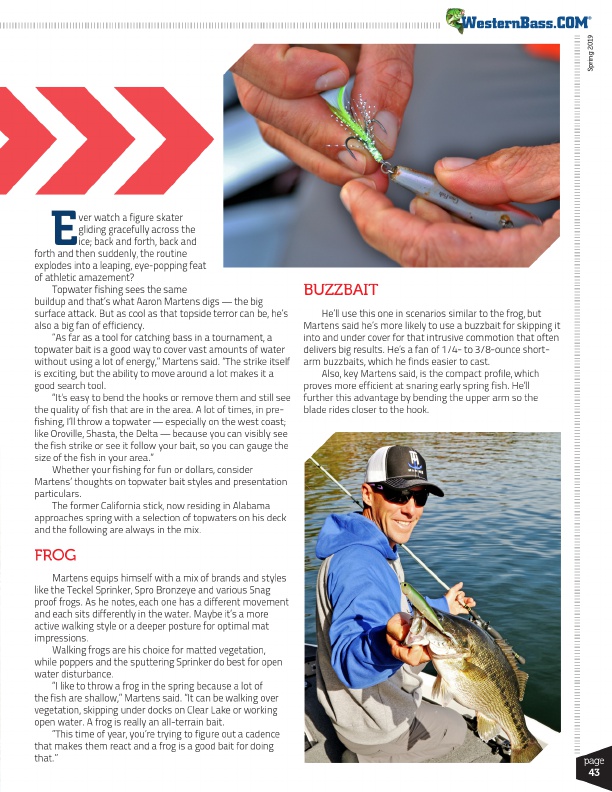
®
Spring 2019
E
ver watch a figure skater
gliding gracefully across the
ice; back and forth, back and forth and then suddenly, the routine
explodes into a leaping, eye-popping feat
of athletic amazement?
Topwater fishing sees the same
buildup and that’s what Aaron Martens digs — the big
surface attack. But as cool as that topside terror can be, he’s
also a big fan of efficiency.
“As far as a tool for catching bass in a tournament, a
topwater bait is a good way to cover vast amounts of water
without using a lot of energy,” Martens said. “The strike itself
is exciting, but the ability to move around a lot makes it a
good search tool.
“It’s easy to bend the hooks or remove them and still see
the quality of fish that are in the area. A lot of times, in pre-
fishing, I’ll throw a topwater — especially on the west coast;
like Oroville, Shasta, the Delta — because you can visibly see
the fish strike or see it follow your bait, so you can gauge the
size of the fish in your area.”
Whether your fishing for fun or dollars, consider
Martens’ thoughts on topwater bait styles and presentation
particulars.
The former California stick, now residing in Alabama
approaches spring with a selection of topwaters on his deck
and the following are always in the mix.
BUZZBAIT
He’ll use this one in scenarios similar to the frog, but Martens said he’s more likely to use a buzzbait for skipping it into and under cover for that intrusive commotion that often delivers big results. He’s a fan of 1/4- to 3/8-ounce short- arm buzzbaits, which he finds easier to cast.
Also, key Martens said, is the compact profile, which proves more efficient at snaring early spring fish. He’ll further this advantage by bending the upper arm so the blade rides closer to the hook.
FROG
Martens equips himself with a mix of brands and styles like the Teckel Sprinker, Spro Bronzeye and various Snag proof frogs. As he notes, each one has a different movement and each sits differently in the water. Maybe it’s a more active walking style or a deeper posture for optimal mat impressions.
Walking frogs are his choice for matted vegetation, while poppers and the sputtering Sprinker do best for open water disturbance.
“I like to throw a frog in the spring because a lot of the fish are shallow,” Martens said. “It can be walking over vegetation, skipping under docks on Clear Lake or working open water. A frog is really an all-terrain bait.
“This time of year, you’re trying to figure out a cadence that makes them react and a frog is a good bait for doing that.”
page 43